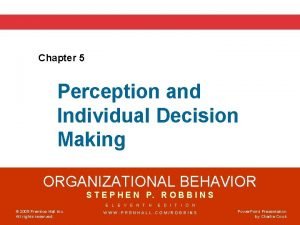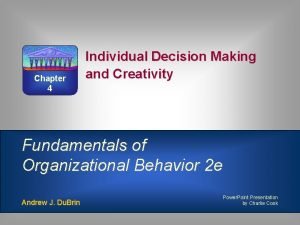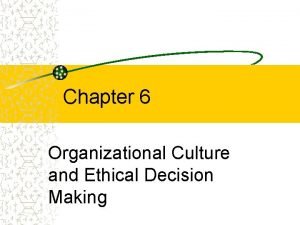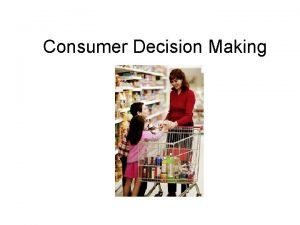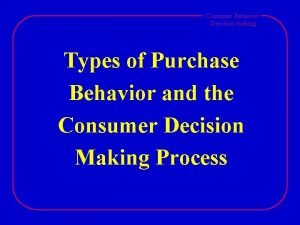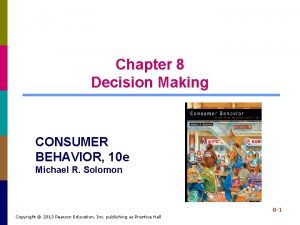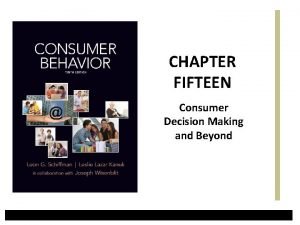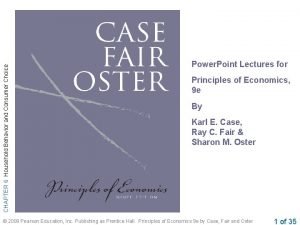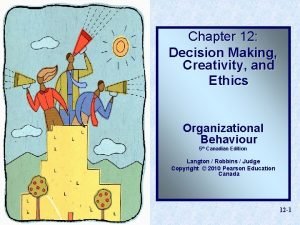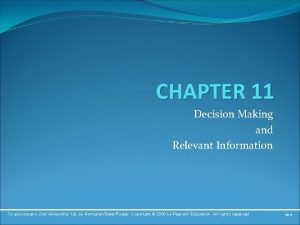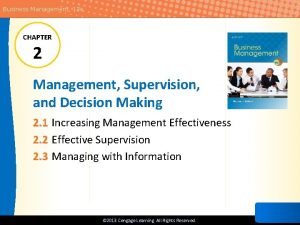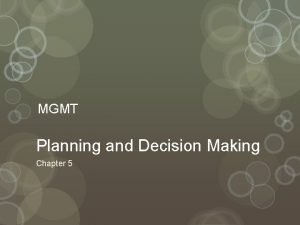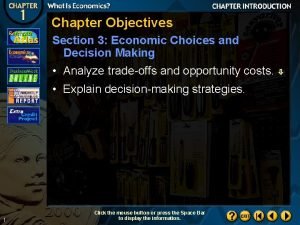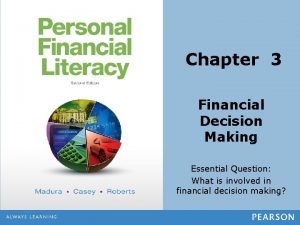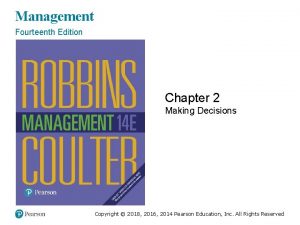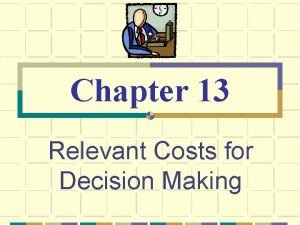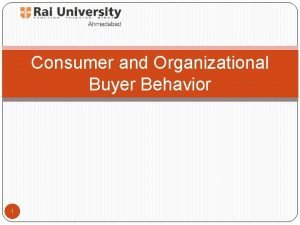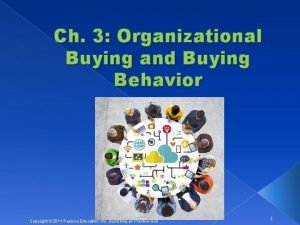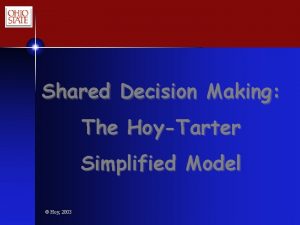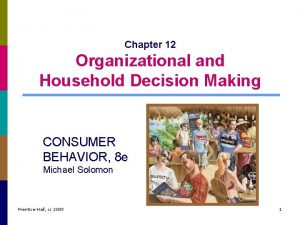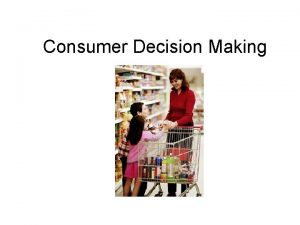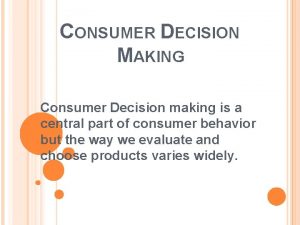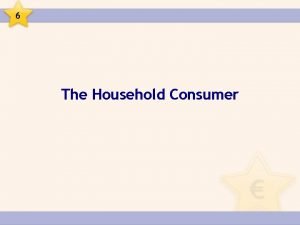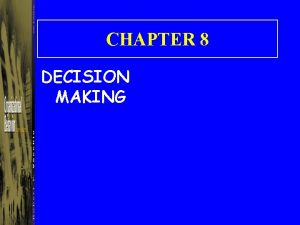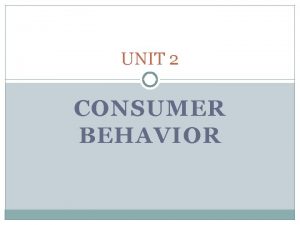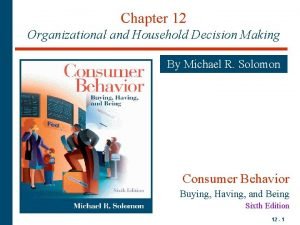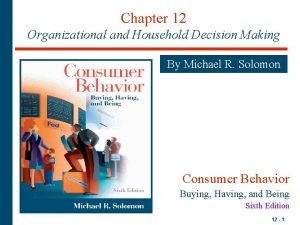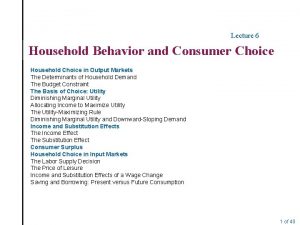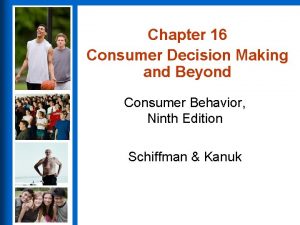Chapter 10 Organizational and Household Decision Making CONSUMER





































- Slides: 37

Chapter 10 Organizational and Household Decision Making CONSUMER BEHAVIOR, 10 e Michael R. Solomon 10 -1 Copyright © 2013 Pearson Education, Inc. publishing as Prentice Hall

Chapter Objectives When you finish this chapter, you should understand why: 1. Marketers often need to understand consumers’ behavior rather than a consumer’s behavior. 2. Companies as well as individuals make purchase decisions. 3. Our traditional notions about families are outdated. Copyright © 2013 Pearson Education, Inc. publishing as Prentice Hall 10 -2

Chapter Objectives (continued) 4. Many important demographic dimensions of a population relate to family and household structure. 5. Members of a family unit play different roles and have different amounts of influence when the family makes purchase decisions. 6. Children learn over time what and how to consume. Copyright © 2013 Pearson Education, Inc. publishing as Prentice Hall 10 -3

Learning Objective 1 • Marketers often need to understand consumers’ behavior rather than a consumer’s behavior. Copyright © 2013 Pearson Education, Inc. publishing as Prentice Hall 10 -4

Roles In Collective Decision Making Initiator Gatekeeper Influencer Buyer User Copyright © 2013 Pearson Education, Inc. publishing as Prentice Hall 10 -5

For Reflection Assume that you are a sales representative for a large company that markets laptop computers. • List all the people that may be involved in the decision making. • Try to match all the people to their possible decision roles as outlined on the previous slide. Copyright © 2013 Pearson Education, Inc. publishing as Prentice Hall 10 -6

Learning Objective 2 • Companies as well as individuals make purchase decisions. Copyright © 2013 Pearson Education, Inc. publishing as Prentice Hall 10 -7

Organizational Decision Making • Organizational buyers: purchase goods and services on behalf of companies for use in the process of manufacturing, distribution, or resale. • Business-to-business (B 2 B) marketers: specialize in meeting needs of organizations such as corporations, government agencies, hospitals, and retailers. Copyright © 2013 Pearson Education, Inc. publishing as Prentice Hall 10 -8

Compared to Consumer Decision Making, Organizational Decision Making… • Involves many people • Requires precise, technical specifications • Is based on past experience and careful weighing of alternatives • May require risky decisions • Involves substantial dollar volume • Places more emphasis on personal selling Copyright © 2013 Pearson Education, Inc. publishing as Prentice Hall 10 -9

What Influences Organizational Buyers? • • Internal stimuli External stimuli Cultural factors Type of purchase Copyright © 2013 Pearson Education, Inc. publishing as Prentice Hall 10 -10

Table 10. 1 Types of Organizational Buying Decisions • Buyclass theory: organizational buying decisions divided into three types, ranging from most to least complex: Buying Situation Extent of Effort Risk Buyers Involved Straight rebuy Habitual decision making Low Automatic reorder Modified rebuy Limited problem solving Low to moderate One or a few New task Extensive problem solving High Many Copyright © 2013 Pearson Education, Inc. publishing as Prentice Hall 10 -11

For Reflection • Summarize the buyclass model of purchasing. How do decisions differ within each class? Copyright © 2013 Pearson Education, Inc. publishing as Prentice Hall 10 -12

Learning Objective 3 • Our traditional notions about families are outdated. Copyright © 2013 Pearson Education, Inc. publishing as Prentice Hall 10 -13

For Reflection • How does the changing nature of the family affect marketing mix decisions marketers make to target families and family members? Copyright © 2013 Pearson Education, Inc. publishing as Prentice Hall 10 -14

Learning Objective 4 • Many important demographic dimensions of a population relate to family and household structure. Copyright © 2013 Pearson Education, Inc. publishing as Prentice Hall 10 -15

The Modern Family • Changes in family structure • Changes in concept of household (any occupied housing unit) Copyright © 2013 Pearson Education, Inc. publishing as Prentice Hall 10 -16

Family Size • Depends on educational level, availability of birth control, and religion • Women want smaller families • The rate of voluntary childlessness is rising, making DINKs a valuable market segment Copyright © 2013 Pearson Education, Inc. publishing as Prentice Hall 10 -17

Sandwich Generation • Sandwich generation: adults who care for their parents as well as their own children • Boomerang kids: adult children who return to live with their parents • Spend less on household items and more on entertainment Copyright © 2013 Pearson Education, Inc. publishing as Prentice Hall 10 -18

Nonhuman Family Members • Pets are treated like family members • Pet-smart marketing strategies: • Name-brand pet products • Lavish kennel clubs • Pet accessories Copyright © 2013 Pearson Education, Inc. publishing as Prentice Hall 10 -19

Family Life Cycle • Factors that determine how couples spend • money: • Whether they have children • Whether both spouses work Family life cycle (FLC) concept combines trends in income and family composition with change in demands placed on income Copyright © 2013 Pearson Education, Inc. publishing as Prentice Hall 10 -20

Variables Affecting FLC Age Marital Status Children in the Home Ages of Children in the Home Copyright © 2013 Pearson Education, Inc. publishing as Prentice Hall 10 -21

For Reflection • For the following products, discuss how having children or not might affect the choices a couple makes. What do such variations mean for marketers? • Groceries • Cars • Vacations Copyright © 2013 Pearson Education, Inc. publishing as Prentice Hall 10 -22

Learning Objective 5 • Members of a family unit play different roles and have different amounts of influence when the family makes purchase decisions. Copyright © 2013 Pearson Education, Inc. publishing as Prentice Hall 10 -23

Household Decisions Consensual Purchase Decisions Accommodative Purchase Decisions Copyright © 2013 Pearson Education, Inc. publishing as Prentice Hall 10 -24

Resolving Decision Conflicts in Families • Interpersonal need • Product involvement and utility • Responsibility • Power Copyright © 2013 Pearson Education, Inc. publishing as Prentice Hall 10 -25

Who Makes Key Decisions in the Family? • Autonomic decision: one family member • chooses a product Syncretic decision: involve both partners • Used for cars, vacations, homes, appliances, furniture, home electronics, interior design, phone service • As education increases, so does syncretic decision making Copyright © 2013 Pearson Education, Inc. publishing as Prentice Hall 10 -26

Factors Affecting Decision-Making Patterns Among Couples Sex-role stereotypes Spousal Resources Experience Socioeconomic Status Copyright © 2013 Pearson Education, Inc. publishing as Prentice Hall 10 -27

Heuristics in Joint Decision Making • Synoptic ideal: the couple takes a common view and act as joint decision makers • Heuristics simplify decision making: • Salient, objective dimensions • Task specialization • Concessions based on intensity of each spouse’s preferences Copyright © 2013 Pearson Education, Inc. publishing as Prentice Hall 10 -28

For Reflection • What exposure have you had to family decisions made in your own family? Can you see the patterns discussed in the chapter in those decisions? Give an example. Copyright © 2013 Pearson Education, Inc. publishing as Prentice Hall 10 -29

Learning Objective 6 • Children learn over time what and how to consume. Copyright © 2013 Pearson Education, Inc. publishing as Prentice Hall 10 -30

Children as Decision Makers • Primary market: kids spend their own • • money Influence market: parents buy what their kids tell them to buy (parental yielding) Future market: kids “grow up” quickly and purchase items that normally adults purchase (e. g. , photographic equipment, cell phones) Copyright © 2013 Pearson Education, Inc. publishing as Prentice Hall 10 -31

Consumer Socialization • Consumer socialization is the process by • which young people acquire skills, knowledge, and attitudes relevant to their functioning in the marketplace Children’s purchasing behavior is influenced by • Parents, family, and teachers • Television and toys • Culture Copyright © 2013 Pearson Education, Inc. publishing as Prentice Hall 10 -32

Figure 10. 2 Five Stages of Consumer Development Copyright © 2013 Pearson Education, Inc. publishing as Prentice Hall 10 -33

Parental Styles for Socializing Children Authoritarian Neglecting Indulgent Copyright © 2013 Pearson Education, Inc. publishing as Prentice Hall 10 -34

Cognitive Development • Limited: Below age 6, children do not use storage and retrieval strategies • Cued: Between ages 6 and 10, children use these strategies, but only when prompted • Strategic: Children ages 10 and older spontaneously employ storage and retrieval strategies Copyright © 2013 Pearson Education, Inc. publishing as Prentice Hall 10 -35

For Reflection • How do the stages of cognitive development relate to a child’s ability to comprehend marketing messages? • How can marketing messages be adapted to meet the appropriate stage of cognitive development? Copyright © 2013 Pearson Education, Inc. publishing as Prentice Hall 10 -36

Chapter Summary • The purchase decisions made by many • • may differ from those made by individuals. Buying for one’s self is different than buying for one’s company. Our traditional notions of family are outdated. Family members play different roles and varying levels of influence. Children learn over time how to consume. Copyright © 2013 Pearson Education, Inc. publishing as Prentice Hall 10 -37
 Energy
Energy Perception and individual decision making
Perception and individual decision making Decision making and creativity organizational behavior
Decision making and creativity organizational behavior Organizational culture and ethical decision making
Organizational culture and ethical decision making Cultural social
Cultural social Pre purchase evaluation of alternatives
Pre purchase evaluation of alternatives Decision making process consumer behavior
Decision making process consumer behavior Stages in consumer decision making process
Stages in consumer decision making process Evoked set
Evoked set Household behavior and consumer choice
Household behavior and consumer choice Individual decision making in organizational behaviour
Individual decision making in organizational behaviour Objectives of decision making
Objectives of decision making Investment decision financing decision dividend decision
Investment decision financing decision dividend decision Chapter 6 prices and decision making assessment answers
Chapter 6 prices and decision making assessment answers Steps in decision making
Steps in decision making Chapter 2 economic systems and decision making
Chapter 2 economic systems and decision making Management chapter 5 planning and decision making
Management chapter 5 planning and decision making Chapter 2 economic systems and decision making
Chapter 2 economic systems and decision making Chapter 2 economic systems and decision making answer key
Chapter 2 economic systems and decision making answer key Chapter 11 decision making and relevant information
Chapter 11 decision making and relevant information Chapter 2 management supervision and decision making
Chapter 2 management supervision and decision making Decision making and relevant information
Decision making and relevant information Options-based planning
Options-based planning Chapter 1 section 3 economic choices and decision making
Chapter 1 section 3 economic choices and decision making Characteristics of buyer behaviour
Characteristics of buyer behaviour Types of buyer behavior
Types of buyer behavior Chapter 3 financial decision making
Chapter 3 financial decision making Copyright
Copyright Relevant cost for decision making solution chapter 13
Relevant cost for decision making solution chapter 13 Similarities between consumers and organizational markets
Similarities between consumers and organizational markets Desert herbivore
Desert herbivore Consumer diversity in consumer behaviour
Consumer diversity in consumer behaviour Consumer behaviour research process
Consumer behaviour research process Decision tree and decision table
Decision tree and decision table Organizational buying process
Organizational buying process Using recursion in models and decision making
Using recursion in models and decision making Using functions in models and decision making
Using functions in models and decision making Model hoy
Model hoy

